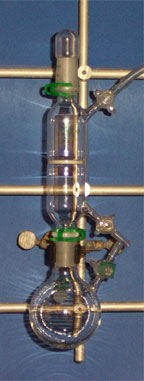
last updated
Schlenk filtration

One very important technique used in this course is a filtration under inert gas. The basic setup consists of a Schlenk flask, a Schlenk frit and a cap. The connection to the vacuum line should be at the top part of the Schlenk frit to remove the contaminants (i.e., water, air). After the drying process, a plastic clip is attached at the connection between the flask and frit.
In order to filter, the setup is inverted before the cap is removed under a positive pressure of the inert gas line). The flask with the solution to be filtered has to be at ambient pressure as well. Then, the flask is opened and the frit is join with it. The connection is secured by another plastic clip. Then, the assembly is slowly inverted, making sure that the solution does not run into the inert gas line. (Sometimes it is better to close them to prevent this from happening. Careful, a significant pressure can build up here! It might be a good idea to hold the setup manually together if low boiling solvents are filtered.) After a short time, the stopcock of the receiving flask is opened to vent the flask. In some cases, a slight vacuum has to be applied to increase the speed of the filtration. However, low boiling solvents or hot solvents evaporate at the frit leaving behind solid material, which often makes it even harder to filter. If the mixture contains a very fine precipitate i.e., NaCl, LiCl, it is advisable to decant the supernatant solution first before transferring the solid onto the frit. This will reduce the chances that the frit will clog in the beginning stages already, which would cause the filtration to take much longer. In some cases, a filter aid like Celite can be used as well.